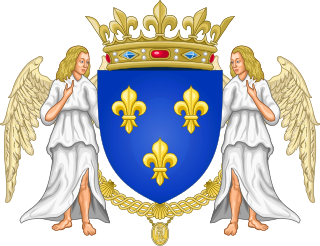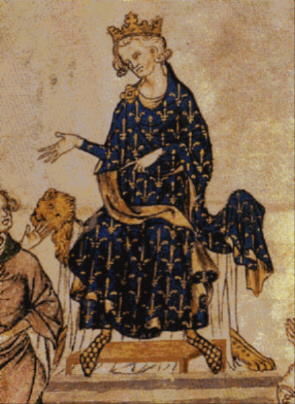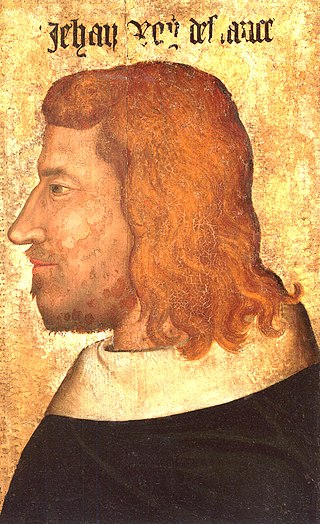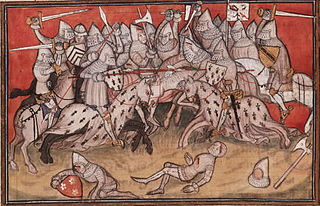Related Research Articles
The 1460s decade ran from January 1, 1460, to December 31, 1469.
The 1330s was a decade of the Julian Calendar which began on January 1, 1330, and ended on December 31, 1339.

The Capetian house of Valois was a cadet branch of the Capetian dynasty. They succeeded the House of Capet to the French throne, and were the royal house of France from 1328 to 1589. Junior members of the family founded cadet branches in Orléans, Anjou, Burgundy, and Alençon.
Aymon, nicknamed the Peaceful, was Count of Savoy from 1329 to 1343.

Philip VI, called the Fortunate or the Catholic and of Valois, was the first king of France from the House of Valois, reigning from 1328 until his death in 1350.

John II, called John the Good, was King of France from 1350 until his death in 1364. When he came to power, France faced several disasters: the Black Death, which killed nearly 40% of its population; popular revolts known as Jacqueries; free companies of routiers who plundered the country; and English aggression that resulted in catastrophic military losses, including the Battle of Poitiers of 1356, in which John was captured.

John II reigned as Duke of Brittany from 1286 until his death, and was also Earl of Richmond in the Peerage of England. He took part in two crusades prior to his accession to the ducal throne. As a duke, John was involved in the conflicts between the kings of France and England. He was crushed to death in an accident during the celebrations of a papal coronation.

The War of the Breton Succession was a conflict between the Counts of Blois and the Montforts of Brittany for control of the Sovereign Duchy of Brittany, then a fief of the Kingdom of France. It was fought between 1341 and 12 April 1365. It is also known as the War of the Two Jeannes due to the involvement of two rival duchesses of that name.

John of Montfort, sometimes known as John IV of Brittany, and 6th Earl of Richmond from 1341 to his death. He was the son of Arthur II, Duke of Brittany and his second wife, Yolande de Dreux. He contested the inheritance of the Duchy of Brittany by his niece, Joan of Penthièvre, which led to the War of the Breton Succession, which in turn evolved into being part of the Hundred Years' War between England and France. John's patron in his quest was King Edward III of England. He died in 1345, 19 years before the end of the war, and the victory of his son John IV over Joan of Penthièvre and her husband, Charles of Blois.

Peter I of Bourbon was the second Duke of Bourbon, from 1342 to his death. Peter was son of Louis I of Bourbon, whom he also succeeded as Grand Chamberlain of France, and Mary of Avesnes.

Joanna of Flanders was Duchess of Brittany by her marriage to John of Montfort. Much of her life was taken up in defence of the rights of her husband and, later, son to the dukedom, which was challenged by the House of Blois during the War of the Breton Succession. Known for her fiery personality, Joanna led the Montfortist cause after her husband had been captured, and began the fight-back, showing considerable skill as a military leader.

The first phase of the Hundred Years' War between France and England lasted from 1337 to 1360. It is sometimes referred to as the Edwardian War because it was initiated by King Edward III of England, who claimed the French throne in defiance of King Philip VI of France. The dynastic conflict was caused by disputes over the French feudal sovereignty over Aquitaine and the English claims over the French royal title. The Kingdom of England and its allies dominated this phase of the war.
This is a timeline of the Hundred Years' War between England and France from 1337 to 1453 as well as some of the events leading up to the war.

The Lancastrian War was the third and final phase of the Hundred Years' War between England and France. It lasted from 1415, when King Henry V of England invaded Normandy, to 1453, when the English lost Bordeaux. It followed a long period of peace from the end of the Caroline War in 1389. The phase is named after the House of Lancaster, the ruling house of the Kingdom of England, to which Henry V belonged.

Mary of Waltham, Duchess of Brittany, was a daughter of King Edward III of England and Philippa of Hainault and was the wife of John IV, Duke of Brittany, known in England as "John V" and "The Conqueror". Mary was made a Lady of the Garter in 1378.
Events from the 1330s in England.

The Hundred Years' War was a series of armed conflicts fought between the kingdoms of England and France during the Late Middle Ages. It originated from English claims to the French throne. The war grew into a broader power struggle involving factions from across Western Europe, fueled by emerging nationalism on both sides.

Bianca of Burgundy, was a Countess consort of Savoy by marriage to Edward, Count of Savoy. She was the mother of Joan of Savoy.

Joan of Savoy, was Duchess consort of Brittany by marriage to John III, Duke of Brittany. Joan was the claimant to the County of Savoy upon the death of her father in 1329 until 1339.
The siege of Cambrai was undertaken by an English army led by King Edward III of England during September and October 1339 in the early stage of the Hundred Years War. At the time Cambrai, located in the Nord department of the Hauts-de-France region in France, was not part of France but a Free imperial city of the Holy Roman Empire.
References
- ↑ Ormrod, W. Mark (2011). Edward III. Yale English monarchs series. New Haven: Yale University Press. ISBN 978-0-300-11910-7.